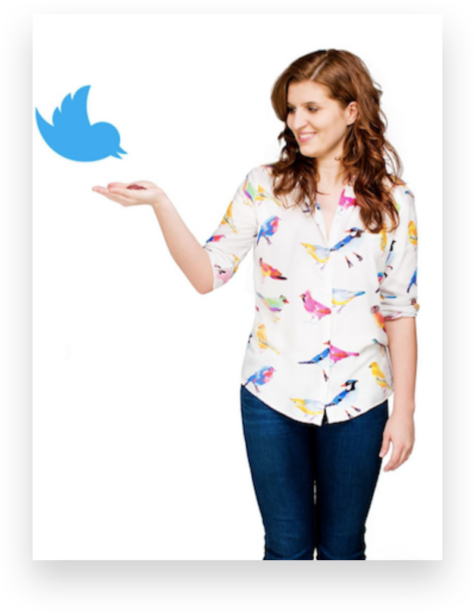Are you a social media buff? Is it your dream to become a professional social media strategist?
Sounds like you? Then keep on reading because this post was written just for you!
Dive deep into our interview with social media strategists from Sleeknote, LiveChat, Prowly, and Brand24.
When starting your adventure as a social media specialist you might wonder:
What does the life of a seasoned social media strategist look like?
The best way to know is by having successful role models in the business. Watching them will get you on top of your social media strategy game and ultimately become a ninja.
Btw: Want to take your social media performance to the next level?
Social Media Strategist Definition
Just for the record, we won’t discuss social media managers who add social media updates randomly here and there to keep social media channels alive, without any deeper science and intention behind it.
The real social media strategist we’ll discuss are experts at managing social communities.
- They live and breathe social media dynamics.
- They understand how to identify audiences that might get hooked on your solutions.
- Also, they can find clever ways to reach and engage those users with the right and compelling message.
Simply put, social media strategists are wizards when it comes to social media science. They know how to stimulate growth and bring tangible results to the table.
For this piece, I interviewed the blood and bones social media strategists from Sleeknote, LiveChat, Prowly, and Brand24 about the role of a social media strategist.
I asked them four basic questions:
- How does a typical day of a social media strategist look like?
- Which social media tasks should be done daily, weekly, and monthly by a social media strategist?
- What are the primary KPIs for a social media strategist?
- What tools should social media strategists use for social media marketing and automation?
Here’s what they told me:
Sam Thomas Davies from Sleeknote
1. How does a typical day of a social media strategist look like according to you?
The role offers a lot of variety, but a typical day usually starts with producing graphics and short videos that can be posted across numerous social media platforms.
This also includes outreach to a network of influencers, industry professionals, and online media to amplify the reach of our posts.
Replying to incoming messages and engaging with our audience in the comments section is also an essential daily task, as well as liaising with our content producers to make sure our long-form articles are informative and appealing.
Staying up-to-date with industry trends and new digital technologies is also a key ongoing task, which then allows me to continually tweak our best practices and measure the resulting impact.
2. Which social media tasks should be done daily, weekly, and monthly by a social media strategist?
Arguably the most important of all tasks is planning.
Making sure we have a clear vision and schedule for the upcoming week is something that is paramount, and ensures actionable and measurable goals are set that can then be broken down into daily assignments.
These weekly goals then feed into our monthly reports, allow for tasks to be optimized, and enable future strategies to be developed.
3. What are the primary KPIs for a social media strategist according to you?
When it comes to measuring the effectiveness of our social media campaigns — for both paid and organic — likes, shares, and comments are great but only tell half the story.
Although measuring traffic and impressions/reach is essential, the click-through rate and engagement rate offers a true metric by which to measure the impact of our posts.
4. What tools should social media strategists use for social media marketing and automation?
Quuu is a great tool that allows for the automation of your social media schedule. Not only that, it will find and suggest content that is relevant to your audience, and consistent with your posts, so you can keep your followers engaged during the downtime between your own posts.
Similarly, Buffer enables all your social media updates to be scheduled from the same place and is a great time saver.
Finally, Mention is a media monitoring tool designed to generate leads through tracking social mentions, finding influencers, and analyzing competitors mentions.
Agnieszka Jaśkiewicz from LiveChat
1. What does a typical day of a social media strategist look like according to you?
I usually start my day with media monitoring and checking out social media notifications from the night.
During the day, I usually work on some new pieces of content, like our LiveChat Tips series.
Then, I usually schedule all the posts and analyze the old ones.
In the meantime, I always check out our Twitter and Facebook page. In this work, you have to have a FOMO (fear of missing out)!
2. Which social media tasks should be done daily, weekly, and monthly by a social media strategist?
Daily: checking out notifications, responding to all customer queries, media monitoring, scheduling new posts, and building relations with customers.
Weekly: working on new pieces of content – graphics, short animations etc., talking with product teams about news and updates we should post on social media.
Monthly: analyzing the statistics, working on our social media “big picture”.
3. What are the primary KPIs for a social media strategist according to you?
We look at our customers’ engagement because we use our social media as a tool to build relations with them.
4. What tools should social media strategists use for social media marketing and automation?
We use Coschedule as our content calendar. I also use Google Analytics to see which posts are most popular.
Rafał Sałak from Prowly

1. What does a typical day of a social media strategist look like according to you?
In a nutshell:
social listening -> publishing -> performance analytics -> planning
One of the very first things I do every morning is checking my social listening feed on Slack to get a grasp on what’s been going on since I went offline.
It shouldn’t take more than 20 mins unless there’s a major comms campaign running.
After I’m through all the feeds, notifications and emails, I look for a piece of content to share with our community – it’s usually some 3rd party news or reports that I’ve found in my morning feed or one of our articles published on Prowly Magazine.
At least once a week I spend around 30 mins analyzing all the types of content we’ve been publishing lately to see what worked and what didn’t. It provides a decent base for planning future content.
In my spare time, I go into the HubSpot social media planner to schedule some tweets – it’s important if you’re going global with your content and need to appear in people’s feeds even when you’re asleep.
Then I end every day with a final look at our channels to make sure every issue has been addressed.
2. Which social media tasks should be done daily, weekly, and monthly by a social media strategist?
It’s good to work on a publishing calendar once a week. That’s also a good moment to check your weekly performance and drive insights for the upcoming days.
I also create performance reports at the beginning of each new month which also provides a valuable source of insights.
Try spending some time reading case studies and industry reports at least two-three times a week.
3. What are the primary KPIs for a social media strategist according to you?
Because none of us is a lonely island, KPIs should be based on business goals.
If our major business goal is +10% sales increase MoM, a social media strategist should focus on delivering KPIs like user growth or website traffic growth, as well as on increasing newsletter subs or content page traffic.
I’m usually against using “likes” or “shares” as KPIs since these are just tools for delivering the end result.
Follower count is important but only if we can show its impact on our business growth, e.g. we increased our follower base from 1000 to 10000, which – through regular content distribution – helped us gain a +30% increase in demo requests.
4. What tools should social media strategists use for social media marketing and automation?
- Smartphone (including a good camera and storage space for high-quality photos and images),
- Photo-editing mobile app (I use Snapseed),
- Image-editing desktop app (I use GIMP),
- Social listening platform (Google Alerts, Brand24, Mention),
- Insights & analytics platform (Sotrender, SocialBakers, Google Analytics),
- UTM builder (free Google Campaign URL Builder, marketing automation tools provide this feature as well),
- Marketing automation platform with a CRM (HubSpot, GetResponse) – ideally combined with a sales CRM,
- Social media feed/widgets on your product website (various WordPress widgets; Prowly for company pressroom feed),
- Planning & publishing (Buffer, TweetDeck, HubSpot).
Magda Urbaniak from Brand24

1. How does a typical day of a social media strategist look like?
I think we can divide a social media strategist’s day into 4 parts (one is additional):
Start: checking what was happen during evening and night online both on own media and in the world in general. Checking what should be done by the end of the day. Plan the day.
Before 12 PM: Implementing the most successful tasks, keeping a hand on the pulse on the time.
12 PM – 2 PM: Creating new ideas, looking for inspiration for the new content, finding benchmarks, figure out if we should add it to our program and how to do so.
2 – 5 PM: Checking how tasks we’ve done in the morning perform, what we can change or boost. Summarize the day.
All the time: keep a hand on the pulse, react, and interact, looking for the new trends.
2. Which social media tasks should be done daily, weekly, and monthly by a social media strategist?
Every single day social media strategist should stay in touch with the audience and grow the community.
I believe this is the main goal of social media overall. Relations and human touch are crucial, but someone who takes care of the community also checks (weekly and monthly) own effectiveness in statistics and evaluate the work.
I would add creating and implementing new ideas every month (or week, why not!).
3. What are the primary KPIs for a social media strategist?
Depends on the goals. I’ve been running a couple of strategies and each of them has different goals, and what we mean by that, KPIs.
When the goal is to build brand awareness then I would say that the number of followers and their interactions will be important. I also track the number of mentions overall thank to social media monitoring tool.
When the goal is to sell the product, I check how many people from my niche got interested during the campaign, how many times the company got a query or how many people logged into a trial or even paid for the product.
Sometimes we have to track results not only from social media platforms stats but also beyond that.
What tools should social media strategists use for social media marketing and automation?
In the ocean of apps, I would recommend Buffer and RazorSocial for automation Brand24 for tracking mentions in our own media along with earn and paid and RivaliQ for tons of statistics.
Wrapping up
A social media strategist role is all about ensuring your company communication is consistent across all the social media channels and aligns with the company and marketing goals.
Whereas your social media goals might look like this:
- Increase social media traffic to the site.
- Increase conversions from social media channels.
These goals are your mantra and all your daily, weekly, or monthly activities should be assigned to them.
A typical day of a social media strategist looks like this:
Any creative tasks, like content curation or finding inspiration for your next social media campaign, should be done in the morning while your mind is still fresh. In the second part of the day, do things that are less focus demanding.
Last but not least, the most important tasks for a social media strategist include:
- Creating a social media strategy – every three months
A social media marketing strategy makes a summary of everything you plan to do and hope to achieve on social media.
The more specific your strategy, the more effective the execution.
Having a social media strategy guides your execution process and lets you know if you’re getting closer to your goals. After all, every post, reply, like, and comment should serve a purpose.
Having a written social media marketing strategy is essential for your productivity. It’s psychologically proven that it helps you stick to your goals and act more methodically.
You should be creating a social media strategy every 3-4 months and update it along the way, whenever you see room for improvement.
- Social media content calendar planning – every three months
Your social media content calendar is for planning content for social channels.
It contains key dates that matter to your business like holidays, events, product launches, campaigns, and more so that you can get ready and involve other people.
This way, rather than making last-minute annoying requests of your designers and copywriters, you can assign things in advance, providing ample time for research and creation, thus ensuring you rarely miss a deadline.
Your social media content calendar should be created every 3 months. This leaves you some space to ensure that you don’t end up scrambling.
These two tasks create the foundation of a social media strategist job, the rest is execution.
- Creating content for social media – weekly
Social media content creation is an essential task that reflects:
- Writing copy for your social media updates
- Recording videos
- Creating infographics
- Taking pictures, mockups and editing them
Do it weekly, unless it demands work from designers and programmers Then dedicate more time to it. Sit and do it each Monday so you can add everything immediately to a social media scheduling tool and implement any changes if necessary.
This saves you a lot of time for other activities, such as building a community and reaching out to influencers and keep everything beautifully organized.
Finally, social media tools social media strategists use daily include:
- Sotrender
- Buffer
- Coschedule
- Mention
- Brand24
- Google Analytics
- TweetDeck
- HubSpot
- Google Campaign URL
- Google Alerts
- GIMP
- Snapseed
- Quu
How did you like this article? Do you have anything to add? Feel free to share your thoughts with us in the comments below.










